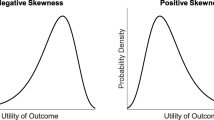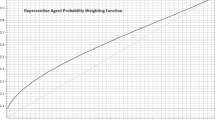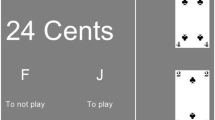Abstract
This paper reports a violation of rank-dependent utility with inverse S-shaped probability weighting for binary gambles. The paper starts with a violation of expected utility theory: one-stage gambles elicit systematically different utilities than theoretically equivalent two-stage gambles. This systematic disparity does not disappear, but becomes more pronounced after correction for inverse S-shaped probability weighting. The data are also inconsistent with configural weight theory and Machina's fanning out hypothesis. Possible explanations for the data are loss aversion and anchoring and insufficient adjustment.
Similar content being viewed by others
References
Abdellaoui, M. (2000). “Parameter-Free Elicitation of Utilities and Probability Weighting Functions,” Management Science 46, 1497–1512.
Allais, M. (1979). “The So-Called Allais Paradox and Rational Decisions under Uncertainty.” In M. Allais and O. Hagen (eds.), Expected Utility Hypotheses and the Allais Paradox. Dordrecht: D. Reidel.
Birnbaum, M. H. and W. R. McIntosh. (1996). “Violations of Branch Independence in Choices between Gambles,” Organizational Behavior and Human Decision Processes 67, 91–110.
Birnbaum, M. H. and J. B. Navarrete. (1998). “Testing Descriptive Utility Theories: Violations of Stochastic Dominance and Cumulative Independence,” Journal of Riskand Uncertainty 17, 49–78.
Bleichrodt, H. and J.-L. Pinto. (2000). “A Parameter-Free Elicitation of the Probability Weighting Function in Medical Decision Analysis,” Management Science 46, 1485–1496.
Bleichrodt, H., J. van Rijn, and M. Johannesson. (1999). “Probability Weighting and Utility Curvature in QALY Based Decision Making,” Journal of Mathematical Psychology 43, 238–260.
Camerer, C. F. and T.-H. Ho. (1994). “Nonlinear Weighting of Probabilities and Violations of the Betweenness Axiom,” Journal of Risk and Uncertainty 8, 167–196.
Dubourg, W. R., M. W. Jones-Lee, and G. Loomes. (1994). “Imprecise Preferences and the WTP-WTA Disparity,” Journal of Riskand Uncertainty 9, 115–133.
The EuroQol Group. (1990). “EuroQol: A New Facility for the Measurement of Health Related Quality of Life,” Health Policy 16, 199–208.
Farquhar, P. (1984). “Utility Assessment Methods,” Management Science 30, 1283–1300.
Fellner, W. (1961). “Distortion of Subjective Probabilities as a Reaction to Uncertainty,” Quarterly Journal of Economics 75, 670–689.
Gonzalez, R. and G. Wu. (1999). “On the Form of the Probability Weighting Function,” Cognitive Psychology 38, 129–166.
Hershey, J. C. and P. J. H. Schoemaker. (1985). “Probability versus Certainty Equivalence Methods in Utility Measurement: Are They Equivalent?” Management Science 31, 1213–1231.
Jensen, N. E. (1967). “An Introduction to Bernoullian Utility Theory: I. Utility Functions,” Scandinavian Journal of Economics 69, 163–183.
Johnson, E. J. and D. A. Schkade. (1989). “Bias in Utility Assessments: Further Evidence and Explanations,” Management Science 35, 406–424.
Kahneman, D. and A. Tversky. (1979). “ Prospect Theory: An Analysis of Decision Under Risk,” Econometrica 47, 263–291.
Karmarkar, U. A. (1974). “The Effect of Probabilities on the Subjective Evaluation of Lotteries,” MIT Working Paper No. 698–74, MIT, Cambridge, MA.
Karmarkar, U. A. (1978). “Subjectively Weighted Utility: A Descriptive Extension of the Expected Utility Model,” Organizational Behavior and Human Performance 21, 61–72.
Lattimore, P. M., J. R. Baker, and A. D. Witte. (1992). “The Influence of Probability on Risky Choice,” Journal of Economic Behavior and Organization 17, 377–400.
Llewellyn-Thomas, H., H. J. Sutherland, R. Tibshirani, A. Ciampi, J. E. Till, and N. F. Boyd. (1982). “The Measurement of Patients’ Values in Medicine,” Medical Decision Making 2, 449–462.
Luce, R. D. (2000). Utility of Gains and Losses: Measurement-Theoretical and Experimental Approaches. Mahwah, NJ: Lawrence Erlbaum Associates, Inc.
Machina, M. (1982). “ 'Expected Utility’ Analysis without the Independence Axiom,” Econometrica 50, 277–323.
Machina, M. (1983). “Generalized Expected Utility Analysis and the Nature of Observed Violations of the Independence Axiom.” In B. P. Stigum and F. Wenstop (eds.), Foundations of Utility and RiskTheory with Applications. Dordrecht: D. Reidel.
Machina, M. (1987). “Choice Under Uncertainty: Problems Solved and Unsolved,” Journal of Economic Perspectives 1, 121–154.
McCord, M. R. and R. de Neufville. (1983). “Empirical Demonstration that Expected Utility Decision Analysis Is Not Operational.” In B. P. Stigum and F. Wenstop (eds.), Foundations of Utility and RiskTheory with Applications. Dordrecht: D. Reidel.
McCord, M. R. and R. de Neufville. (1984). “Utility Dependence on Probability: An Empirical Demonstration,” Journal of Large Scale Systems 6, 91–103.
Prelec, D. (1998). “The Probability Weighting Function,” Econometrica 66, 497–528.
Quiggin, J. (1982). “A Theory of Anticipated Utility,” Journal of Economic Behavior and Organization 3, 323–343.
Rutten-van Mölken, M. P., C. H. Bakker, E. K. A. van Doorslaer, and S. van der Linden. (1995). “Methodological Issues of Patient Utility Measurement. Experience from Two Clinical Trials,” Medical Care 33, 922–937.
Tversky, A. and C. Fox. (1995). “Weighting Risk and Uncertainty,” Psychological Review 102, 269–283.
Tversky, A. and D. Kahneman. (1992). “Advances in Prospect Theory: Cumulative Representation of Uncertainty,” Journal of Riskand Uncertainty 5, 297–323.
Tversky, A. S. Sattath, and P. Slovic. (1988). “Contingent Weighting in Judgment and Choice,” Psychological Review 95, 371–384.
Wakker, P. P., I. Erev, and E. U. Weber. (1994). ”Comonotonic Independence: The Critical Test between Classical and Rank-Dependent Utility,” Journal of Riskand Uncertainty 9, 195–230.
Wakker, P. P. and A. M. Stiggelbout. (1995). “Explaining Distortions in Utility Elicitation Through the Rank-Dependent Model for Risky Choices,” Medical Decision Making 15, 180–186.
Wu, G. (1994). “An Empirical Test of Ordinal Independence,” Journal of Risk and Uncertainty 9, 39–60.
Wu, G. and R. Gonzalez. (1996). “Curvature of the Probability Weighting Function,” Management Science 42, 1676–1690.
Yaari, M. E. (1987). “The Dual Theory of Choice under Risk,” Econometrica 55, 95–115.
Author information
Authors and Affiliations
Rights and permissions
About this article
Cite this article
Bleichrodt, H. Probability Weighting in Choice under Risk: An Empirical Test. Journal of Risk and Uncertainty 23, 185–198 (2001). https://doi.org/10.1023/A:1011136203223
Issue Date:
DOI: https://doi.org/10.1023/A:1011136203223




